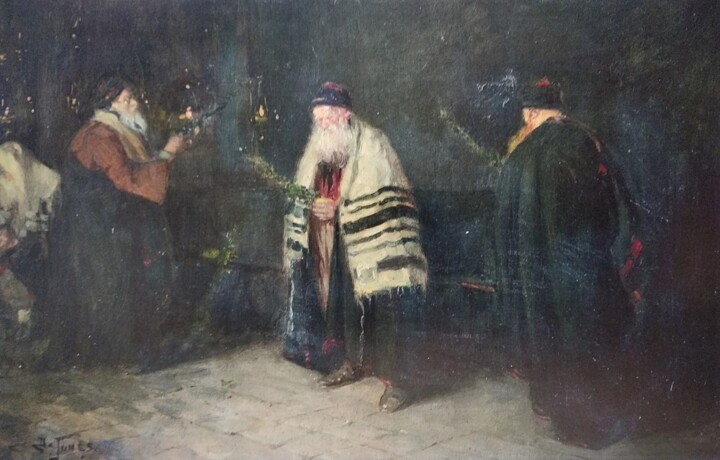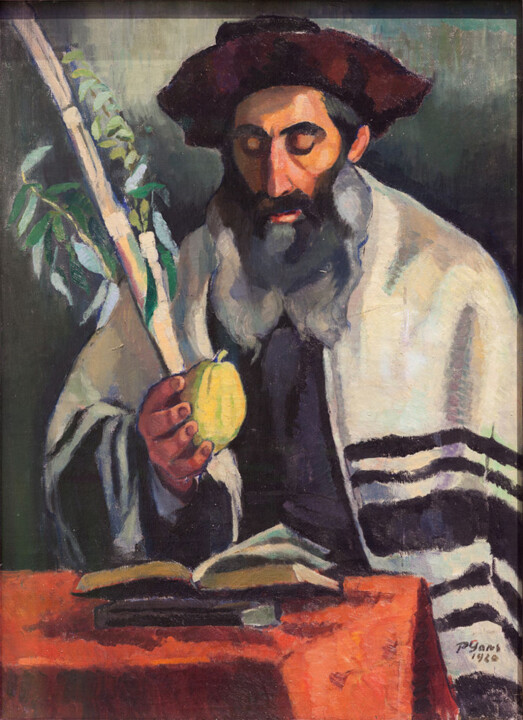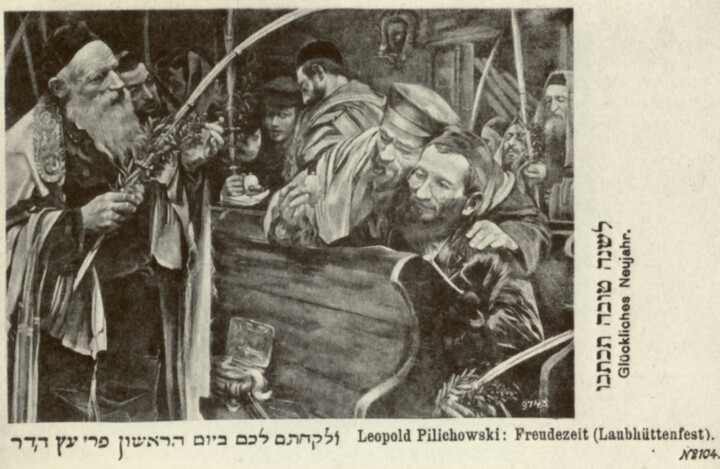Sukkot, also known as the Feast of Booths, is a major Jewish celebration that takes place in the fall, immediately following Yom Kippur. It commemorates the forty years that the Israelites lived in temporary cabins, or sukkahs, in the desert after their exodus from Egypt. It is also an agricultural festival that expresses gratitude for the annual harvest.
The tradition involves building a sukkah where families eat, rest and, in some cases, sleep for the duration of the holiday. This practice is not only a reminder of the deprivations and divine protection experienced by ancestors, but it also strengthens community and family ties.
Arts and illustrations play a crucial role in the celebration, serving as both educational tools and means of expressing the joy and spirituality of the holiday. Sukkahs are often elaborately decorated with handmade works, which may include drawings, paintings, and other forms of art, reflecting the cultural and religious significance of this festive period.
History of Sukkot Art
Antiquity and Middle Ages
Initially, the art related to this holiday was manifested primarily through the architecture and decoration of the sukkahs themselves, as well as the ritual objects used during the festival, such as the lulav and the etrog. The earliest artistic depictions in Jewish art can be found in ancient synagogue mosaics, such as those found in Israel, which depict scenes of the holiday or associated symbols.
In the Middle Ages, Jewish illuminated manuscripts began to illustrate scenes from this event, often in the margins of religious texts. These illustrations not only depicted the liturgical aspects of the feast, but also incorporated elements of everyday life, emphasizing the community and family relevance of the celebration.
Renaissance in the Modern Era
With the advent of printing, illustrated prayer books and machzorim (holiday prayer books) became more accessible, and with them, representations multiplied. Renaissance Jewish artists sometimes integrated Sukkot scenes into larger works that depicted various aspects of Jewish life.
Contemporary period
In the 20th century, art took on a new dimension with artists like Marc Chagall, who incorporated elements of celebration into their works, often reflecting themes of exile and return. Modern and contemporary art is no longer limited to painting or drawing, but extends to art installations, photography and multimedia, exploring more abstract and conceptual interpretations of the holiday.
In the contemporary world, community art projects around Sukkot are common, where groups come together to build and decorate sukkahs in creative ways, often with a focus on ecological or social themes, reflecting modern concerns while remaining true to the spirit of the party.
Here are some notable examples of illuminated manuscripts and early engravings that illustrate the festivities:
The Sarajevo Haggadah - A 14th-century illuminated manuscript, containing detailed illustrations of Jewish holidays. Although primarily dedicated to Passover, this manuscript also shows scenes of Jewish celebrations and decorative elements that reflect the customs of the time.
The Darmstadt Haggadah - This medieval manuscript, dating from the 15th century, includes illustrations of the event, including images of Jews wearing the lulav and etrog, and others eating in a sukkah, clearly illustrating the traditional practices.
The Mahzor of Worms - A 13th-century manuscript that includes illustrations of this holiday This prayer book for the Jewish holidays features miniatures showing the construction of sukkahs and the blessing of the four species.
The Birds' Head Haggadah Missal - This manuscript from southern Germany (circa 1300) contains unique illustrations where the human figures have bird heads, an iconographic feature. It includes scenes from the holiday of Sukkot, depicting the activities and rituals specific to this period.
Themes and Symbols in the Art of Sukkot
The Sukkah
Theme: it is a temporary cabin built for the duration of the festival, is the central symbol of this festival. It recalls the fragile shelters in which the Israelites would have lived during their 40-year journey in the desert after the exodus from Egypt.
Symbolic: It represents human vulnerability and dependence on God for protection and sustenance. Its temporary and often precarious structure underlines the notion of faith in God despite uncertainty and instability. It is also a reminder of the importance of humility and gratitude for the blessings received.
The Four Species (Arba Minim)
Theme: The four species — etrog (lemon), lulav (palm), hadas (myrtle) and arava (willow) — are plant elements that are brought together and shaken during celebration.
Symbolic: Each species has its own meaning and together they symbolize the unity of the Jewish community, with each bringing its unique qualities to form a harmonious whole. Traditionally, each plant represents a different part of the body or type of person, which reinforces the idea of diversity within the unit:
- Etrog: The heart, the centrality of faith and wholeness.
- Lulav: The backbone, righteousness and leadership.
- Hadas: The eyes, clarity of vision and illumination.
- Arava: Lips, prayer and expression.
The Harvest
Theme: This date is also known as the Harvest Festival, celebrated at the end of the agricultural season in Israel. It marks the time when fruits and crops are harvested and stored for the winter.
Symbolic: The harvest symbolizes abundance and divine providence. It is a time of giving thanks for the blessings of nature and a reminder of the importance of sharing bounty with those less fortunate. The joy of the harvest also reflects spiritual joy and gratitude to God for his generosity.
Artists and Notable Works
- Bernard Picart and the Procession of Palms among Portuguese Jews

Procession of the Palms among the Portuguese Jews, Bernard Picart (1724)
This work represents a procession during Sukkot, typical of Portuguese Jewish communities. Although the exact date of creation is not specified, this type of engraving often highlights the importance of the lulav (set of palm fronds) in rituals. The procession highlights the communal aspect of the festival, where participants often parade with all four species, symbolizing unity and devotion. - David Junès, “Rabbins during the Feast of Sukkot”
 Rabbis, Sukkot festival, David Junès (1874-1938)
Rabbis, Sukkot festival, David Junès (1874-1938)
This oil on canvas by David Junès, an artist active in the early 20th century, illustrates rabbis celebrating Sukkot in Tunis. The work captures the mood of reverence and community at the feast, with the central figures holding the four species. This painting may also reflect the cultural interaction between Jewish traditions and the North African environment, showing the adaptation of rituals to local contexts. - Paula Gans, “In Prayer at the Feast of Tabernacles”

Praying at the Feast of Tabernacles, Paula Gans, 1920
Paula Gans, a German Jewish artist, offers in this work an intimate scene of prayer in a sukkah during Sukkot. His work often reflects the daily life of Jewish communities in Europe before World War II, and this painting illustrates the piety and spirituality of the Feast of Tabernacles observances. - Greeting postcard depicting the Feast of Tabernacles

Greeting postcard depicting the Feast of Tabernacles, 1900
This greeting postcard, dating from around 1900, depicts Laubhüttenfest (Sukkot in German) and is typical of the period for its use of floral motifs and festive scenes. It would have been used to send greetings, illustrating scenes from community and family life in the sukkah, reinforcing the link between tradition and personal communication. - Shalom Koboshvili, “Prayer, Feast of Sukkot”

Prayer, Feast of Sukkot, Shalom Koboshvili, gouache on paper, 1938
Shalom Koboshvili, a Georgian artist, depicts in this gouache on paper a scene of prayers during the holiday of Sukkot. His works are often rooted in the life of the Georgian Jewish community, and this specific piece shows the fervor and devotion of the practitioners, showcasing the ritual and communal aspects.
The Art of Sukkot in the Contemporary World
Digital Art
Yaacov Agam is an Israeli artist known for his kinetic and optical works. Although his works are not exclusively focused on this holiday, his use of geometric shapes and vibrant colors can be interpreted in the context of the holiday as a way of visualizing the themes of renewal and joy. His digital creations could theoretically include animations depicting the construction of a sukkah or the movements of the lulav and etrog, introducing an interactive dimension to the celebration.
Photography
Frédéric Brenner, a French photographer, has created works that document the lives of Jewish communities around the world. His photographs of families building or dwelling in their sukkahs capture the cultural nuances of Sukkot, highlighting the variations and constants of this practice across different cultures.
Art Installations
Sukkah City, an art installation project that took place in New York in 2010, is a perfect example of a contemporary interpretation of the sukkah. This international competition invited architects and artists to reinvent this celebration. The finalist designs were displayed in Union Square, offering the public an exploration of tradition through modern prisms of sustainable design, innovative materials and avant-garde concepts.
Exhibition and Permanent Installation
The Israel Museum in Jerusalem often organizes exhibitions around this event, including contemporary sukkah installations by artists and designers. These exhibitions explore how this place, as a temporary space, can be interpreted in ways that comment on current social, environmental or political topics.


 Jean Dubreil
Jean Dubreil